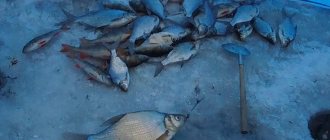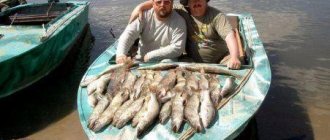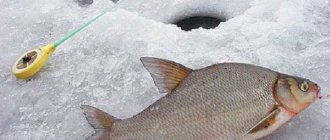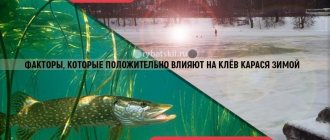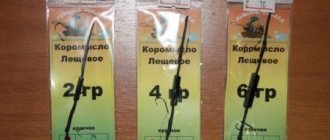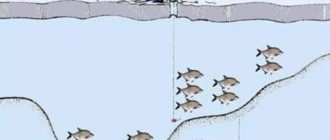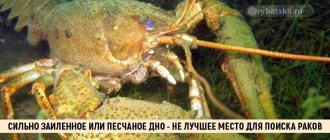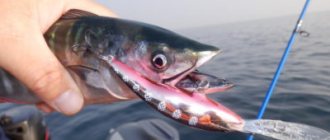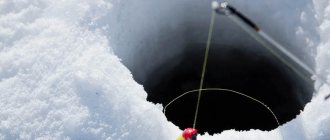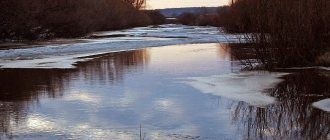The success of ice fishing is largely determined by correctly selected gear, bait and fishing location. Unlike other peaceful fish, bream is active throughout the year, only with the onset of cold weather does its behavior and taste preferences change somewhat.
To catch the coveted trophy, you need to become more familiar with the peculiarities of its habits during this period. Properly equipped tackle for bream in winter is the key to obtaining good results.
Tackle for bream in winter
To catch bream, both from a boat and from the shore, the same equipment is often used. This limited choice is due to the general design features of all gear. A bite signal is given either by a float or a nod.
The first fishing device is more popular than the second alarm. Their peculiarity lies in the principle of their work - to convince the object of fishing that the proposed bait is a real delicacy, food.
This is precisely the task of setting up the tackle for bream in winter in order to be guaranteed to attract its attention and provoke it to attack.
The nod has a significant bend angle, which provides a sufficient degree of sensitivity and fully normalizes the weight of the jig, and weight does not play a significant role here.
Thanks to this device, the fisherman can clearly and quickly adjust the gear taking into account specific fishing conditions, and also makes it possible to make a timely hook. If you follow these recommendations, you will be 100% successful.
Fishing rods equipped with a float are used both in reservoirs with standing water and with strong currents.
The components of the gear are:
- rod;
- fishing line;
- hook with sinker;
- float.
For information! Fishing for bream in winter is equally effective both with a purchased fishing rod and with one made with your own hands - from hazel.
The main condition is that the tackle should be quickly assembled and disassembled; the fishing line should be reeled in without any problems, which is important when moving from one hole to another. There is a fairly large assortment of jigs on the market for catching bream; a nod most often acts as a bite signal.
Fishing thread with a thickness of 0.15-0.20 mm is the most effective option for ice fishing.
Popular fishing methods
Each angler chooses the fishing method independently, depending on personal preferences and conditions of the reservoir. There are quite a lot of them, so there is always a choice.
Harvester fishing
Used when fishing from ice in currents. A regular fishing rod with a nod for winter fishing is used.
Device:
- A feeder on a leash 15-20 cm long is tied to the main line through a swivel with stoppers.
- At a distance of 5-6 meters from it there is an insert with 3 hooks, the length of which is 1.5-2 meters. The first hook is located at the end of the fishing line, after which a weight of 2-3 pellets is attached so that the tackle can sink to the bottom. Next, there are two more hooks at equal distances.
- Main line – 0.3 mm; leashes – 0.18-0.22 mm, length 15 cm; sharp hooks, with a luminous drop of phosphorus, No. 5-8; the feeder is closed, weighing 90-120 grams, preferably weighted with lead so that it does not drift away with the current.
Fishing technique:
- The feeder is filled with food, and animal bait (bloodworms, maggots) is put on the hooks. The larvae will attract fish with their movement.
- Hooks are first lowered into the hole and carried away by the current.
- The feeder goes down to the bottom.
- The fishing rod is fixed on a stand in anticipation of a bite.
When fishing with a combine, when the tackle has already been lowered into the water, you should not walk on the ice above the place where the hooks were carried - the noise of footsteps may frighten a cautious bream.
To hell
Catching bream with a devil is quite popular and involves using a bait with a treble hook without a bait. It has a teardrop-shaped or barrel-shaped body. The tee can be attached movably or immovably. The mass of the bait is more than 1 gram.
The following baits are better suited:
- length from 10 to 20 mm;
- diameter 3-5 mm;
- color: brown, black, green;
- body shape – cone-shaped or in the form of a roller.
You can put colored cambrics or beads on the hooks. Additionally, beads located on the fishing line in front of the bait will help attract the attention of bream. The main thing is that it has a wide opening and moves easily along the line.
The devil is applicable on any fishing rod with a nod. The fishing line should be set as thin as possible (0.12-0.14 mm) to increase the sensitivity of the gear. The essence of fishing for devils is to make the bream want to hunt by actively moving the bait in the water.
Fishing technique:
- The bait sinks to the bottom.
- 3-4 taps are made with the devil on the ground to raise a cloud of turbidity.
- There is a short pause and the bait smoothly rises up.
- At the end of the drive it is necessary to cut after a pause. Usually the fish bites just when the bait is fading.
The devil has proven itself most effective in the current, where the ability to actively play with it in the water is much higher.
Catching bream in winter with a devil largely depends on a correctly selected nod. Its length must be at least 10 cm. In this case, the devil with its mass must bend at least 2/3 of the length of the fully extended nod.
Ring fishing
This gear allows you to catch bream from a boat and the shore on ice-free reservoirs, as well as directly from the ice. Particularly catchy in the current. It’s easy to make it yourself or buy it ready-made in the store.
Manufacturing:
- A ring with an outer diameter of 50-65 mm and an inner diameter of 15-25 mm is cast from lead. The thickness of the ring is 6-8 mm.
- A cut is made in the ring for the passage of a thick fishing line or cord, and a hole with a diameter of 3-5 mm is drilled to the side of it.
- The main fishing line (diameter - 0.25-0.35 mm) is passed through the hole in the wall of the ring, and a swivel with a stop bead is tied at the end.
- A fishing line 1-1.2 m long with a diameter of 0.2-025 mm with two or three hooks is attached to the swivel. The length of the leads is 0.2-0.4 m, thickness is 0.15-0.18 mm.
Fishing technique:
- A feeder filled with complementary food is lowered to the bottom on a thick cord. The feeder is made of metal mesh with a large mesh. Volume – 4-6 l. when fishing from ice, its diameter should allow it to pass through the hole. The cord from the feeder is fixed by the fisherman near him.
- The hooks catch the bait. The ring is put on the cord from the feeder through the cut and the tackle is lowered into the water in anticipation of a bite.
The principle of operation is that a large-volume feeder is constantly located at the bottom, distributing bait, and the hooks, thanks to the ring, are located in the coverage area of the feeder with each cast. When a bite is transmitted to the nod, the ring comes off the cord through a cut and is pulled upward along with the prey.
Instead of a regular lead ring, a sinker called “eggs” is now often used. It consists of two lead balls held together by wire, which is bent like a pin. The wire closes the balls together, and when there is a bite, the line of the feeder slips between them. The line going to the rod is passed through a ring on the wire.
There are no special requirements for the rod, the main thing is that the nod accurately conveys the bite.
A predator often stays close to the feeder and is attracted by approaching fish, so experienced fishermen advise changing the usual bait to live bait - then you can catch a pike or pike perch along the way.
Catching bream in winter with a garland
The tackle is very simple, both in manufacturing and in fishing techniques. A regular ice fishing rod with a sensitive nod and reel will do.
To make a garland, take a fishing line with a thickness of 0.18-0.2 mm and several devil jigs, which are best suited for catching bream, are tied on it at different distances. The number of hooks can be different and depends on the depth of the reservoir.
- Most jigs should be at the bottom of the gear in order to better fish the bottom layers. The distance between them is at least 0.3 meters.
- The nod is selected in such a way that, under the weight of the tackle, the bending angle does not exceed 25 degrees.
- If there is a current in the reservoir, the garland is equipped with additional weights.
The advantage of fishing with a garland in winter is the ability to simultaneously fish different layers of the reservoir. When fishing, you should make smooth upward movements of the rod with a hook.
Typically, fishing with a garland occurs without the use of bait, but many anglers use bloodworms or maggots, baiting them through one jig.
Helicopter
On a river with a fast current, you can fish quite successfully with a helicopter. The easiest way to make it is as follows:
- the end of the main line (diameter 0.25-0.30 mm) must be passed through the eye of a sinker weighing 30-40 grams and secured with a swivel;
- A leash about a meter long is attached to the swivel (line diameter is 0.18-0.2 mm), at the end of which a bottom from a tin can is attached. The line should pass through a hole made exactly in the center of the tin;
- Several hooks are knitted between the swivel and the bottom with a distance of 20-25 cm between them.
The essence of fishing is this: the sinker sinks to the bottom, and the leash with hooks, thanks to the tin, is carried away by the current. At the same time, it oscillates in the water, attracting fish to the hooks with nozzles. Bloodworms are better suited for baiting in winter.
Even if the “helicopter” is not the main method of fishing, it is better to take this equipment with you - with its help it is easy to determine the depth at which the fish is holding.
Fishing with a float
Catching bream in winter on a reservoir or lake where there is no current is usually done with a float rod. Float fishing in winter is no different from summer fishing. The main feature is that bream is more careful in winter, so it is necessary to use the thinnest gear possible.
The float tackle consists of:
- short winter rod with reel;
- fishing lines;
- sinkers;
- hook.
Bloodworms are most often used as a bait. Instead of a sinker, you can use a jig with bait.
When catching bream with a float in winter, it is important to properly set up the tackle so that it slowly sinks to the bottom and the fish does not feel the weight of the weight or jig when swallowing the bait. To do this, it is necessary that the equipment slightly exceeds the weight of the float’s carrying capacity.
Bream has very fine hearing and is able to pick up the slightest sound vibrations transmitted along the fishing line. Therefore, while fishing, you should refrain from even simple conversations.
Fishing tactics
Catching a bream that is not too active in winter is quite difficult, so it is better to stick to the tactics of experienced fishermen that have been developed over the years.
Bream fishing in winter happens:
- Migration. During the fishing process, the angler moves a lot on the ice of the reservoir, exploring new places. A large number of holes are drilled, while the angler explores the topography of the bottom and the depths of the reservoir, uses various baits, lures and methods of catching bream. All this is done to identify the most catchable place.
- Zonal. With this tactic, the angler first looks for a suitable place. In the optimal place for catching bream, several holes are drilled, the distance between which is 10-20 meters, and they are fed. After this, all that remains is to fish all the holes until a particularly catchy one is found. When the bite fades in one hole, the fisherman moves on to the next and so on in a circle. If the fish bites very well, then you can stop at one hole for the entire fishing trip.
- Stationary. If the angler is familiar with the reservoir, then he has a permanent feeding place where 2-3 closely spaced holes have been drilled. The main advantage is that a stationary point can be equipped by installing protection from cold and wind, which is impossible when constantly moving on ice.
You can also catch bream at night in winter. Night fishing refers to stationary fishing, since in the dark it will be very problematic to move around the reservoir in search of new places. When fishing at night, a tent is installed above the hole, in which the fisherman is protected from the wind. Inside there is a source of heat and light, and there is also a seating and even a sleeping place.
Bream is quite shy, so you should not drill holes closer than 6-7 meters from each other.
Fishing for bream in winter on the current - gear
Fishing in bodies of water with a current has its own characteristics, knowledge of which allows you to effectively equip the tackle and quickly attract potential prey.
First of all, keep in mind that:
- go fishing with a constant supply of fresh oxygen throughout the winter season, which is not possible when catching peaceful fish in lakes and low-flow reservoirs.
- Winter gear components must be durable and reliable. The use of heavier equipment in this case is quite justified.
- Groundbait mixtures should consist predominantly of heavy ingredients. It is recommended to lower the bait upstream of the fishing point.
To catch prey on the current, it is quite effective to use all sorts of modifications of fishing rods, in particular, it is good to use a filly along with a float equipment, a fishing rod equipped with a reel and a nod.
It is also effective to equip the fish with a nod, and the fishing rod and reel with the components of a float rod.
There should be an end sinker at the bottom, and a leash 20-50 cm long fixed 5-10 cm from it, which is equipped with 1-2 hooks. In the case of jigs, small models installed one after another on a leash with a distance of 5-7 cm are suitable.
It is better to make a bite alarm from a clock spring, since its sensitivity level can be adjusted due to its length.
In order to prevent freezing of the throughput cambrics and rings that make up part of the nod equipment, it is necessary to treat them with wax.
It is advisable to connect the main line and the leash using a small carbine and swivel. It is also good to have a swivel where it connects to the sinker. Sinker weight 10-50 g.
How to assemble it yourself
Winter donks are sold in stores, but if you assemble them yourself, it is both more economical and easier for the fisherman to understand the design and make it at his own discretion.
High-quality winter bottom tackle should be:
- unnoticeable;
- reliable;
- functional.
For peaceful fish
The tackle is mounted on the main line or on a piece of monofilament line in the following order:
- a stopper is placed on the base and moved up 1.5 meters;
- then the main load of 20-50 grams is put on;
- further, another stopper fixes the load, and it moves a meter up the line;
- a leash is knitted 20 cm below the stopper;
- Another leash is tied even lower 20 cm;
- then the stopper is put on;
- then a small load;
- The swivel is tied last;
- Another leash is tied to the swivel.
The result is a rig with sliding weights that press it to the bottom, but do not create resistance when the fish bites. Hooks for winter donkeys with a sliding load are taken from numbers 12–16 according to the European classification. It is better if the hooks are red; they provide camouflage and blend in with the bait, which is:
- bloodworm;
- purulent worm;
- red maggot.
When using other baits, the hooks are black or golden. To ensure maximum camouflage of the winter bottom rig, it is tied on a piece of fluorocarbon or fluorocarbon fishing line. Such materials are absolutely transparent and invisible in water. Large fish are especially careful, they are scared away by ordinary fishing line, and the use of fluorocarbon significantly increases the catchability of the gear.
The rig, tied on a separate piece of fishing line, is tied to the base using the loop-to-loop method before fishing, and after fishing is finished it is removed and wound onto a reel. It is convenient to store such installations in thick plastic bags with a zip fastener. Before packing the tackle in a bag, you should dry it thoroughly so that the fishing line does not rot and the hooks do not rust.
On a predator
The predatory fish also catches the donk, intended for its peaceful counterparts, because it also loves to feast on bloodworms or worms. Special donks for predators are different in that they are designed for fishing with live bait. The equipment should hold the live fish in a position that is attractive to pike or perch.
A heavy sinker can cope with such a task, and thanks to the long leash, the live bait moves freely in the water column and does not look like bait at all.
To confidently hold live bait and reliably catch a predator, tee hooks are used on a leash made of fluorocarbon fishing line 0.3 mm and 50-70 cm long.
A winter donka for a predator is mounted on the main fishing line. A sliding weight is placed at the end of the base, and a swivel is placed below it, thus ensuring free sliding of the weight along the fishing line. A leash with a tee is tied 20-30 cm above the load, onto which live bait is put. After the bottom is lowered into the hole, the live bait goes into free swimming, and the fish bite is registered using a flexible whip or bell attached to the fishing line.
The base is on the reel, and even if a predator makes a rapid jerk, the line comes off the spool freely until the angler is hooked.
Attention! Small crucian carp is the best live bait, even on a tee it can attract attention
Fishing for bream in winter on a reservoir
When catching bream in reservoirs, a jig or a winter version of a float rod is used.
The float rod equipment consists of the following elements:
- fishing thread with a cross-section of 0.1-0.12 mm;
- small size and bright color float , for loading which a load is used that will lower it 1 cm into the water;
- miniature jig , equipped with a hook with a long shank or a simple small hook.
If a hook is used, a weight should be installed in front of it. In this case, leashes are not required to catch bream.
Jig tackle is quite simple to prepare:
- forests with a diameter of 0.08-0.1 mm, the color of which is chosen to match the color of the water in the reservoir or a colorless version;
- the flexible nod should have a length of 10-15 cm, it should have no memory and have a slight windage;
- tungsten jig
Fishing for bream in winter from ice
During the winter season, the activity level of bream is not much different from the warmer seasons, and it is still a worthy contender. When surviving, fish often present various unpleasant surprises: torn rigs, broken ends.
Based on such observations, experienced fishermen recommend taking fishing rods that have been tested with large catches and have hard whips when going ice fishing.
For the same reasons, it is not advisable to use very thin monofilament. Compared to roach, a fishing line with a cross-section of 0.08 mm will be sufficient to catch it; for catching bream, it is better to give preference to threads with a diameter of 0.15 mm, but fishing line with a cross-section of 0.15-0.2 mm is also suitable.
The main thing is to focus on the size of the intended trophy.
Both float and nodding gear are suitable for winter hunting. These should be mobile fishing tools that can be quickly reeled in or disassembled.
Groundbait and bait
Good bait is the key to successful fishing. In winter, bream reacts much worse to bait, so you should feed it in advance. With the onset of cold weather, fish switch to protein-rich food, so animal components must be present in the bait.
Groundbaits
- Bloodworms are used as a base, additional elements are breadcrumbs, semolina, milk powder, and sunflower seed cake. Fine plant particles should create clouds of nutrient turbidity that lure fish to the fishing site. But basically, the success of catching bream in winter directly depends on the number of bloodworms in the bait. Maggots and chopped worms are also added, but these may not be effective. You should use fragrances very carefully in winter - the strong smell can scare away cautious bream.
- Many fishermen advise using frozen bloodworms as complementary food. To do this, plastic forms are filled with water, sand and bloodworms and placed in the freezer until completely frozen. During fishing, these frozen cubes sink to the bottom. Such bait melts slowly, retaining the bream at the fishing point for a long time. The main advantage is that frozen bloodworms can be stored for a very long time without losing their taste.
Bream should be fed 1-2 days before fishing. But it is necessary to remember that uneaten plant remains of bait in cold water quickly begin to rot, scaring off the fish with an unpleasant odor, so you should not overdo it with their quantity.
Baits
In winter, bream almost completely switches to animal food, so among the baits, bloodworms predominate, which the fish almost always go for. Next come maggots and worms. Various combinations of these three attachments are also effective: maggot-worm-bloodworm, worm-bloodworm-worm, etc.
Of the vegetable baits in winter, bream can only bite on mastyrka. Cooking recipes vary slightly, but they all have the same basics:
- peas;
- semolina;
- water.
Auxiliary ingredients:
- honey;
- sunflower oil (unrefined);
- sugar;
- eggs;
- vitamins.
Recipe:
The peas are soaked for several hours and then cooked until tender. Next, you need to crush it and, adding semolina, knead it with your hands until the dough stops sticking to your hands. During the mixing process, you can add auxiliary substances that will help attract fish.
For catching bream in winter, the mastyrka recipe changes slightly - semolina is half replaced with wheat flour. In this case, you definitely need to add vitamins - crushed Hexavita or Revita tablets.
Bream prefers large-volume baits, so bloodworms must be baited in bunches. When fishing with mastyrka, you should remember that it is not stored for a long time, so you should not take too much with you.
Catching bream in winter at night
For night hunting for the desired trophy in the dark, a classic winter fishing rod is used, the equipment is standard.
The following types of equipment show good results:
- usual execution - nod, line, jig;
- bite alarm, line, hook;
- set of hooks, “garland”;
- tackle equipped with a float, fishing line and hook.
There are situations when a winter fishing rod is equipped with a bell, which creates a sound alert about a bite that has occurred. To catch a large specimen, it is advisable to use a “devil” type jig.
For information! It has been noted that using a garland rig gives a better chance of a good catch than hunting with a jig. This tackle includes a final sinker and a main line equipped with several leashes up to 5 cm long, which have sharp hooks.
Since the use of a “garland” requires the presence of attachments, it will not be possible to play here. At night, the jig does not show very good results, unlike the hook, and the quality of its work is somewhat different.
The guard begins to move on the jig fishing rod not due to bites, but due to the impacts made by the fish on the forest. A more successful option is considered to be a rig using a regular hook; the bream can be pulled out after almost every bite.
Types of bream fishing rods
Winter fishing rods for bream can be divided into several categories according to the method of equipment and place of use:
- jigs;
- float;
- for the current.
This division is a bit arbitrary, and the criteria often overlap, for example, you can catch bream with a jig fishing rod in a weak current, although it is not as catchy as on a riser.
Types of bream fishing rods
Float rod
The tackle consists of the following elements:
- fishing rod having a cork or foam handle;
- open coil;
- a whip with a length of 15 cm, at the end of which a tulip or a special ring is mounted for passing the main line;
- inconspicuous monofilament with a thickness of 0.14-0.16 mm and a length of 15-20 m;
- two jigs , where the lower one is fixed to the end of the line, and the upper one is placed 15-20 cm higher.
If fishing takes place on a river, then the lower jig can be effectively replaced with a lead sinker in the shape of a ball, and the upper one with a long leash (30-40 cm), equipped with a hook with a thin shank No. 12-14. In this version, the bite alarm is a tandem of a metal nod and a winter float.
Jigs
The tackle shows good performance throughout the entire freeze-up period; it consists of:
- a Balalaika type fishing rod equipped with an elastic whip (length 15-20 cm);
- dark monofilament with a diameter of 0.1-0.12 mm;
- lavsan nod (length over 10 cm) with a rich red tip and an opening for the line;
- baits such as pellets, ants, uralka, drops, bananas;
- hooks with long shank No. 14-16;
- flexible and sensitive nod, made of metal, 10-15 cm long.
Particularly popular among baitless jigs are Devil lures of dark and silver colors, the length of which is 12-15 mm.
Winter feeder
This tackle comes with:
- carbon fiber tool (length 70-80 cm), equipped with an elastic and sensitive quiver tip, guide rings, a cork handle with a spool mount;
- inertia-free reel model (size up to 1500);
- monofila with a thickness of 0.16-0.18 mm (for the main line);
- monofilament with a diameter of 0.12 mm (for leashes);
- feeder trough;
- equipment such as Paternoster , asymmetrical loop, Gardner loop.
Installation of gear
It should be emphasized that when fishing in the current, winter donks have clear advantages over rigs for vertical fishing. Thanks to the use of main weights of 5-50 g, the equipment is not carried away by the current from the fishing spot and does not lift from the bottom.
Hooks with a nozzle are always in the bottom layer, and when the bottom bites, self-hatching occurs. If the angler sees a bite, then to be sure he hooks the fish. But even if the attention of a winter fishing enthusiast is distracted and he does not have time to hook, the fish is caught on its own under the weight of the main sinker.
Winter donka tackle for bream or crucian carp consists of:
- a piece of monofilament fishing line 1.5−2 m long with a diameter of 0.18−0.22 mm;
- 3-4 leashes with hooks on a monofilament line with a diameter of 0.10-0.16 mm;
- main cargo weighing 5−50 grams;
- float stops;
- additional weight 5−10 g.
When making a winter donka “helicopter”, used for catching bream in strong currents, a “rail”, a small box without end walls, is also mounted on the tackle.
Due to the absence of walls and installation with a parachute, the box vibrates in the current, creating an attractive visual picture, and provokes the fish to bite. Instead of a box, oval pieces of tin or plastic are used, but the principle of fastening and operation of the donkey remains the same.
Catching bream in winter with a float
Equipment for catching bream in winter
Depending on the size of the fishing object, equipment for ice fishing is selected. If the potential small-sized prey is a white bream, then the usual version of the gear is suitable, but for hunting a large specimen that lives at considerable depths, a more serious installation will be required.
In addition, standard equipment is recommended to be used when the fish is hungry and active, and when the fish is sensitive - for passive biting.
Standard equipment with one float
The set of elements for this equipment option includes:
- main sinker;
- shepherd boy;
- hook;
- float.
The use of a jig is allowed here. For winter fishing to be successful, it is necessary to very clearly configure the gear, where the selection of the buoyancy of the float, the weight of the sinkers with a hook and bait, or a jig must be carried out correctly.
The combination of two sinkers and a hook is highly sensitive, where the weight of the equipment itself should be less than the carrying capacity of the float. The main thing is that the float is on the surface. You can check this point by clicking on it.
If, after immersion in water, it does not return to its original position very quickly, then everything is done correctly.
Using a buoy in the rig prevents the float from pulling out the entire load; it sinks. The catching tackle must be clearly adjusted. Because there are situations when the float or nod jumps out sharply at first, and no action is taken during hooking.
Such a development of events becomes possible when the object of the fishing, feeling the weight of the jig (supporting bait), tries to immediately free itself from the foreign substance.
Thanks to fine tuning, it is possible to prevent such consequences: when a fish swallows the bait, the float begins to slowly float up and take the weight on itself, without scaring it at all. It is important to make the hook in a timely manner before the float is completely on the surface of the water surface.
The float should be deepened not by 1.5-2 cm, but by 5-7 cm, which will increase the operating range of the float, and the bream will have a reserve of time to perform the hooking. You can save time on setting up gear by adjusting it at home.
Equipment for deep waters with two floats
In promising areas of the reservoir, where the depth is at least 8 m, it is effective to use a special set of components for a winter fishing rod for bream.
It is not rational to use a lightweight version of the equipment in such conditions, the dive will be slow, straightening will not occur fully, the bait will move under the influence of currents in the water column or the line will begin to bend in an arc, reducing the degree of sensitivity of the equipment.
To avoid such a problem during fishing, fishermen equip the tackle with a heavy main sinker. Accordingly, the float used is quite large, but it can be easily noticed by fish.
For such cases, during installation, an additional small bite alarm is provided, which is placed on top, 5 cm from the surface. The large float is deepened to 1 m.
Setting up the gear is carried out according to a similar principle. At the moment the sub-shepherd is raised, the working tackle begins to appear on the surface, but only a small bite alarm will emerge first, the weight of which does not affect the weight of the nozzle that ends up in the mouth of the prey.
The weight of the bait is held by a large float. Composite winter floats for bream work the same way. It is more effective to use the described installation of gear in calm areas of a reservoir with great depth.
Where to look for bream in winter and a rational search method
A river, lake, pond, reservoir—everywhere has its own nuances. I could be wrong, but finding bream on a reservoir is “more” easier compared to a river or lake. The flooded bed, already starting from the coastline, is a “washboard” - sharp drops to depth, holes and mounds give way to shallow areas.
Bream and white bream love heterogeneous bottoms. In some places they organize rest stops, in others they prefer to feed.
If, as an example, we consider my case, then the situation is as follows.
Previously, the village was located between the taiga hills on the very bank of the Angara. After the water level in the reservoir rose, half of the hills went under water, along with the roads and the relatively flat territory of the village. Beautiful bays with areas attractive to fish appeared - deep steep banks with bottom “plateaus” and the riverbed topography of the Angara became one whole.
The most frequently feeding bream and bream can be found at the entrances to the bays. Here, deep channel edges give way to vast clay and sandy “glades”. Such areas are rarely littered with snags and all sorts of bottom debris. In the absence of massively dying vegetation, the oxygen regime turns out to be favorable and the bream feels great and fills its paths. But he doesn’t go far from reaching the depths. At least in winter.
But knowing the bottom topography and the preferences of the fish is just the beginning.
Having found the first coastal edge, I skip it and look for the next drop to depth. Having found the difference, I make a central hole and from there, following the pattern of a six-pointed star, I begin to drill the next ones. I measure 6-7 meters in steps and drill.
I made a hole and immediately fed it. This is one of the disadvantages of bream fishing. You go and know that you won’t have to be distracted by catching other fish. You prepare a dozen fishing rods and bait at home. The fishing box turns out to be packed to capacity.
There is an important point . We are accustomed to covering the hole with snow when leaving. When fishing for bream, you don’t need to do this. For fishing in relatively shallow water, “illuminated” holes lure underbream. Large bream in winter are lovers of the depths and there is no need to be afraid that the light will alert the fish. The sun's rays simply do not reach it.
We made a perforation on the ice - we begin to fish. If you're lucky, the first bites occur. If within 20-30 minutes the fishing rods have not shown themselves, we take up the drill and resume the search.
The process is labor-intensive, but it ultimately turns out to be worth it. Fishing occurs at different depths, which expands the fisherman’s capabilities. As a reward for your efforts, you can determine the areas of the bottom of the reservoir most visited by bream.
It's like when fishing for burbot. If you find a path, you will be with fish.
A nod to the winter bream fishing rod
Nodding fishing rod equipment
The traditional design of the tackle with a nod is the presence of one jig. You can also use an auxiliary retractable leash or a separately placed higher leash with a simple hook.
Here, the success of fishing will depend on the setting; the nod at the time of installation should bend excessively, and when the load is released, it should gradually straighten, and with greater amplitude. This technique will give the fisherman time to react, and the prey will not have time to feel the weight of the bait.
Considering the relevance of this problem when catching bream in winter, it is advisable to equip the fishing rod with a reverse nod. You can make it yourself, maintaining the necessary bend. The range between the free state and the load state should be 5-7 cm.
The choice of nod depends on the specific weight of the jig.
To equip a fishing rod, you should use a reel that has a sufficient number of locking grooves, the classic one has 4, the rest are made independently. This technique will allow you to adjust the length of the overhang as accurately as possible and set the nod to the working position.
For information! If you are hunting for bream in a reservoir with deep soft silt or in areas with a strong flow of water, then using a rocker is quite effective.
Catching bream in winter with a crossbow
A distinctive feature of the tackle is the large gap between the lower and upper positions of the nod. The use of a crossbow is important for stationary fishing; in addition, it makes it possible to slightly play with the bait. It is equally good to use different versions of the crossbow in such conditions.
Among the positive characteristics of this design are:
- Greater amplitude of lifting the nod.
- The ability to adjust the tackle in accordance with the weight of the jig by changing the position of the elastic band.
- Installation in the uppermost position when biting. If a bite is missed, the angler will need to reset the nod to the working position.
To equip the tackle, the same elements are used as for a classic nodding fishing rod. It is noteworthy that it is quite possible to make it at home, using a simple model of a winter fishing rod from the store as a basis. The equipment is made taking into account all bream rules.
Floats for winter fishing
The variety of winter floats for fishing is not as great as in summer gear. However, this does not mean that the selection and equipment can be approached carelessly. On the contrary, winter time requires thin and elegant gear and careful adjustment of fishing rods. The shapes and sizes, coloring of the floats are secondary. There is no need to try to see them from afar - everything happens in the hole, under the angler’s feet. Their load-carrying characteristics are much more important. As already noted, the most important function of this element of gear is to unload the weight of the bait and equipment. Moreover, the more sensitive the tackle, the easier it is for the fisherman to distinguish the sluggish bites of passive and accurate fish.
Forms
All winter floats, mostly small in size, are made of hard foam or balsa. The body shape can be different - in winter there are no summer factors in the hole, such as current, wind, distance to the fishing spot. The float is immersed under water to a depth of 1.5-5 cm. Various barrels, cones, tablets - the shape is secondary. More important is the correct setup and selection of equipment weight. The most commonly used are classic round, ovoid or cylindrical floats.
In principle, provided the settings are correct, there is no difference - the choice depends on the wishes of the fisherman. For example, a tablet or puck is easier to see when ascending due to its larger lateral area. This question is not for everyone. For night fishing, you can apply a drop of phosphorus varnish to the float. Such a luminous indicator is better visible in a dark hole in poor lighting conditions. For shallow fishing with the lightest jigs, instead of a float, foam stoppers are sometimes placed directly on the fishing line - if their carrying capacity is suitable for the weight of the equipment. What is more important is not the shape of the alarm itself, but the way it is attached to the fishing line.
Attachment to fishing line
Attaching the float to the fishing line on a winter fishing rod is carried out in several ways:
- Through a vertical hole in the body in the center. This results in a non-removable mount.
- Use a casing or PVC tube to hold the leg at one point, tightly fixed in the body of the float or hinged on a loop. A more versatile removable accessory that allows you to install another alarm without changing the installation. Only cambric is put on the fishing line.
- Floats with side slot. The line is passed through the cut and clamped with a pin. It also allows for replacement without dressing.
- Through a crooked hole in the body. Such models do occur, but rarely. The main principle of winter fishing rods is simplicity and reliability. Here there are only additional difficulties in passing the fishing line through the body.
There are no long-distance casts on ice - there is no point in bothering with a super-reliable fastening method. Even if the float falls, it will not go further than the hole or the space under your feet. In winter, correctly configured installation and ease of operation in the cold are more important.
Catching bream in winter with a jig
The relevance of this gear increases in reservoirs with great depths, as well as in areas with complex bottom topography. Since bream is often not constant in its preferences, it is recommended to have several types of bait in your arsenal to obtain a guaranteed result.
It was noticed that a jig in the shape of a banana, black or yellow color especially quickly attracts the attention of prey.
It is recommended to choose a fishing point in areas of the reservoir with rich aquatic vegetation and a depth of 1.5 m. It is possible to catch the coveted trophy in water areas near the pits, since the fishing object at this time is not very mobile.
When catching fish with a jig, performing a high-speed retrieve is not as promising as when performing a retrieve with a high oscillation frequency and short freezing of the jig. Such animation will only attract a small thing - the bream.
It is better to slowly rise from the bottom with low-frequency oscillations and stops, the duration of which is no more than 3-4 seconds.
They drill holes at a distance of 15-20 m from each other; it is enough to make 15-20 of them. Feeding is done using a dump feeder, and fishing begins from the first fed hole. The number of lifts in each is 10-15 times.
If there are no bites for a long time, then the tackle needs to be raised 5-7 cm from the bottom and pause, placing the fishing rod on a stand. The fishing process should take place slowly, holding the fishing line between two fingers of one hand, and carefully selecting it with the other.
How to make a winter fishing rod for bream?
You can make a homemade fishing rod from a piece of plastic plinth (25 cm long and 2.5 mm wide) and a plastic tube (15 cm long and 2-2.5 cm in diameter).
Algorithm of actions:
- Measure the required size of the future workpiece on the plinth.
- Cut out a sharp triangle, leaving 5 cm untouched.
- Clean out any uneven surfaces using sandpaper.
- Heat the plastic tube over the fire until it becomes soft.
- Give the tube a flattened shape.
- Insert the baseboard blank into the resulting hole.
- Burn the edges to prevent the baseboard from falling out.
- Make a hole for installing a regular coil by using a drill with a 5 mm drill bit. It can be secured with a plastic or metal bolt.
- Cut a stand for the fishing rod from a plastic plinth; it should be 7-8 cm long and 4 cm wide.
- Make a hole for the rod.
- Make a nod from a clock spring.
- Use an elastic band to secure the nod.
- Insert 2-3 weights into the handle.
- Durable tackle is ready for use.
Bait for catching bream on the lake in winter
When catching bream on lakes, two types of bait are used: “pure” bloodworms and “white” composition.
The bloodworm attracts fish and holds them in place. They often use small ones, which are more economical in consumption: usually 100...200 g is enough for a day of fishing. Complementary foods must be fresh.
The composition of “white” groundbait is the same as in summer, but has no binding elements and is weakly flavored. It includes:
- white breadcrumbs - 300 g;
- roasted and ground hemp or sunflower seeds - 100 g;
- unground fine oat flakes - 50 g;
- crumbly undercooked millet porridge - 400 g;
- bran - 50 g;
Here are the main components that can be supplemented with flavorings to increase efficiency.
To prepare the bait, use a small bucket. First mix everything dry, then add water, bringing the mixture to the required consistency. As a result, it should be slightly damp and crumbly.
It is expensive, but much easier to buy ready-made mixtures from trusted manufacturers. The range of baits in fishing stores is decent.
The recipes for winter from Sensas, Traper, Dunaev and other companies are quite working and successfully attract fish.
Feeding
Feeding is carried out through drilled holes and consists of three stages.
First, the “white” bait is lowered into the smallest feeder. Stuff it lightly so that it immediately disintegrates when it gets into the water. Its goal is to create a column of turbidity and, due to this and the aroma from the flavoring agent, attract fish to the fishing site.
Next, lower the feeder with bloodworms, opening it, not bringing it to the bottom 1.0...0.5 m. Immediately add a second portion of bloodworms, opening the feeder at the bottom. At the final stage, the “white” complementary food is lowered using a large feeder. They open it without bringing it to the bottom 2.0...1.0 m.
In lakes where there is a lot of ruffe, the “white” bait should be repeated. Its layer will cover the bloodworms and will not allow the ruffs to accumulate in the fishing area. If this does not help, then next time you should refuse the bloodworms and use it only during supplementary feeding, when the bream has already approached and will drive away the small things.
After feeding, the bream approaches the hole in about half an hour, this depends on its concentration in the reservoir. The waiting time can be used to have a snack and admire nature.
If possible, it is better to feed the holes in the evening. In the morning, first they go around them, catch them, without stopping for more than 2 minutes on those where there are no bites. “Leaving” the hole, it is fed with a medium feeder, filled with “white” groundbait and a small amount of bloodworms. “Drop” the mixture higher so as not to scare the fish.
The supplementary feeding operation is carried out in the middle of the day. Moreover, if the ruff does not bother you, they only do it with a bloodworm.
Fishing for bream in winter on the devil
Of the variety of baits, the devil, equipped with hooks and sinkers, is especially popular. Its weight should be from 1 g, color black, brown or green, effectively equip it with beads of different colors.
For catching bream, options in the shape of a drop or a roller are suitable, the length of which is 10-20 mm and the diameter is 5 mm. Hooks should be selected in large sizes.
The principle of catching devils:
- The bait is lowered to the bottom and knocked several times to create turbidity.
- Pause for 5 seconds and again raise it by 30 cm, shaking it slightly.
- The bait should be cast without stopping.
- Having raised the fishing rod and made a three-second pause, perform a confident hook.
- If there are no bites, then you need to move on to the next hole.
- Compliance with ice safety rules is mandatory.
Catching bream on a garland in winter
This tackle, unpretentious in terms of assembly, is presented on the market in various versions, but the most popular option is considered to be a simple winter fishing rod equipped with a reel and line with a cross-section of 0.18 mm.
Installation of small jigs is carried out at different distances from each other, but not less than 30 cm. It is recommended to additionally load the garland only on reservoirs with strong currents. The deflection angle of the guard is 20 degrees, which allows you to maintain the level of sensitivity of the gear.
Having decided on the fishing location, you need to drill holes 5-10 m from each other. After feeding, they begin to be caught one by one.
Catching bream with a reelless bait
The tackle consists of:
- fishing rod 40-45 cm long;
- medium-hard nod;
- coils;
- scaffolding with a cross section of 0.1-0.2 mm;
- reelless jig.
Fishing is done from top to bottom - vertically. The jig moves smoothly, creating the illusion of a drowning insect. If you make sudden movements, the fish will become wary and leave. If there are no bites, the jig is led to the bottom.
Most often, the bite occurs the moment it touches the bottom. It’s good to tap on the bottom to draw the fish’s attention to it. The best option is 120 vibrations per minute. Beads on a jig work great.
Catching large bream in winter
To attract the attention of large fish, experienced fishermen use:
- red worm;
- crawls;
- burdock moth larvae;
- protein dough.
It is possible to learn about the taste preferences of trophy specimens in a particular body of water only through experimentation. Bait is of particular importance; it is unlikely that you will be able to catch a large bream without an attractive bait mixture.
It is advisable to periodically add animal food, for example, bloodworms, into the hole.
When going for a trophy, you need to prepare high-quality tackle, consisting exclusively of durable elements.
Sensitive tackle for bream in winter
High sensitivity gear is equipped with:
- float (2-3 floats);
- special sinker;
- mobile limiter;
- hook;
- leash, the length of which determines the degree of sensitivity of the instrument.
It is recommended to use ultra-sensitive tackle on reservoirs with calm water, since it is a passive instrument. If you use a nod with a large bend angle, you can significantly expand its capabilities. You should not use a jig instead of a sinker.
The main secrets of good tackle
Knowing certain tricks allows you to always stay with the catch:
- durable fishing rod equipped with special legs;
- monofilament scaffolding with a cross section of 0.18 mm;
- metal and hard guard;
- leash made of monofilament with a cross-section of 0.12 mm;
- hooks from No. 12;
- jigs weighing 10 g.
Winter bream fishing, with the right approach, almost always brings the desired result. The main thing is to use durable tackle, have several bait options and feed the holes enough. Depending on the degree of activity of the fishing target, the pace of the retrieve is selected.
Only a competent approach and knowledge of key secrets gives a chance to catch the coveted trophy.
The most catchy
Any tackle for catching bream cannot be considered the best or the worst - they are all good in the right conditions, the right choice, strategy and fishing tactics are important. Gear for winter bream fishing is just a variable; gear is chosen depending on the fishing conditions. In some conditions one equipment will perform well, in others another. So there is no fishing tackle for bream in winter as such. Choosing the right fishing rod is one of the success factors.
For successful fishing you need:
- choose the right body of water and time;
- find a parking and feeding place;
- choose and install the gear correctly;
- correct supply of bait and feeding;
- careful behavior on the ice, without unnecessary noise.
Reference. Popular gear for catching bream are float and nod fishing rods. Installation of such fishing rods is easy and neat, unlike winter rods.
